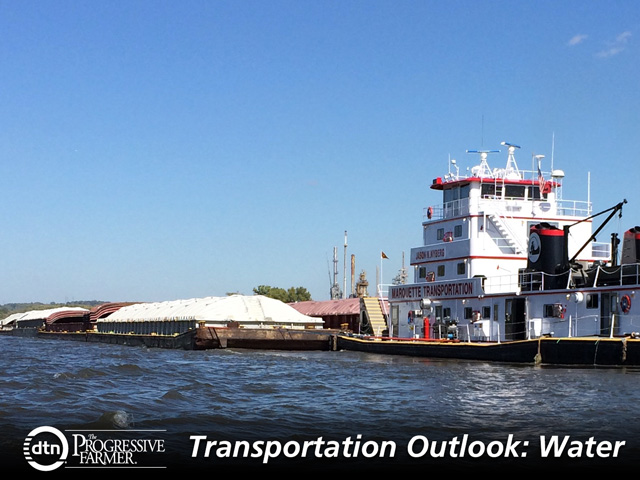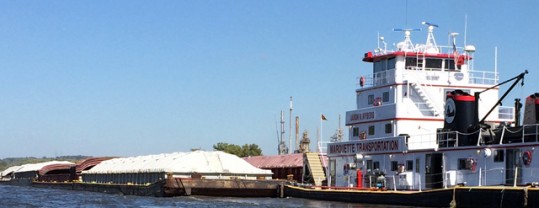In 2016, the biggest issue for the aging river system will be ongoing and new repairs to some of the key lock and dam areas along the Mississippi, Ohio and Illinois rivers.
As 2015 ended, this became even more evident and critical. The U.S. river system was under siege: heavy rains caused massive flooding and added pressure to the aging water transportation network.
Flooding is unusual for this time of year, but the extreme weather systems that moved through Texas, up into the Midwest, and across the Ohio River Valley at the end of December brought on excessive rains, which were 200% to 300% above normal in a compressed period of time, according to Tom Russell, of the Russell Marine Group.
River closures stopped barge traffic heading to the Gulf and closed barge grain terminals on the Mississippi River, but also the Illinois and Ohio rivers. The Mississippi River at Cape Girardeau, Missouri, was rising to a near-record level as January began.
“Water from all the flooded rivers will be pushing down the Lower Mississippi for several weeks,” Russell told DTN.
As the Lower Mississippi continues to rise, additional safety measures are being imposed by authorities in the New Orleans-Baton Rouge harbors, some of which are being imposed for the first time. Many terminals are restricted to daylight-only docking/undocking including all mid-stream berths.
On Jan. 10, the U.S. Army Corps of Engineers opened the Bonnet Carre Spillway to keep the volume of Mississippi River flows at New Orleans from exceeding 1.25 million cubic feet per second as the flood waters moved south into Baton Rouge and New Orleans. This was the earliest opening of the spillway on record. The NWS forecast on Jan. 13 said the Mississippi River at Baton Rouge was above flood stage (35 feet) at 41.73 feet and will continue rising until cresting at around 43.5 feet on Jan. 18. (See http://goo.gl/…
But even as rivers began to reopen to barges, there were concerns. For example, with the lower Illinois River, traffic had to be slow as bridge clearances were expected to remain problematic and some levees are weak. The Mississippi River reopened to barge traffic Jan. 6 with safety restrictions in place, tow size limits, and some areas with daylight only movement.
Flooding can be destructive to locks and dams due to debris crashing into the aging locks, and in some floods, barges have broken loose from their moorings and slammed into locks and dams causing major damage. This week, near Vicksburg, Mississippi, several barges broke loose and hit bridges, thanks to rapidly rising water.
AGING SYSTEM UNDER PRESSURE
The weather headache that is kicking off this year had added to the pressure the water transportation system had already been facing.
A 2013 study funded by the United Soybean Board, in coordination with the Soy Transportation Coalition, showed that 54% of the Inland Marine Transportation System’s structures are more than 50 years old and 36% are more than 70 years old. More than half of the structures that are part of the U.S. inland waterway system for river barge shipping exceed their 50-year usable lifespan, according to a soy checkoff-funded report. (https://goo.gl/…)
“Our nation’s inland waterway system, including our inventory of locks and dams, is not simply a contributing factor to the success of U.S. soybean farmers, it is a dominant one,” the Soybean Transportation Coalition (STC) stated on its website.
“For much of the key soybean growing regions of the country, barge transportation is the most economical, efficient mode for transporting soybeans to our export terminals. At least 65% of U.S. corn, soybean, and wheat shipments exit the country via the Gulf, and products such as DDG, petroleum, fertilizer, sand, gravel, mulch, steel, are shipped up and down the U.S. river system,” said STC.
In February 2015, President Barack Obama’s budget for fiscal year 2016 was released and included $4.732 billion in gross discretionary funding for the Civil Works program of the U.S. Army Corps of Engineers (Corps). Jo-Ellen Darcy, assistant secretary of the Army for Civil Works said that, “This budget supports the core mission areas of coastal and inland navigation, reducing flood and storm risks, and restoring aquatic ecosystems.” (To see how funding will be distributed among the appropriations accounts, go tohttp://goo.gl/…)
The work has started in areas such as the northernmost part of the Mississippi River where repairs are underway at Lock and Dam 7 and 9.
“We are currently dewatering Lock and Dam 9, near Lynxville, Wisconsin,” Patrick Moes, public affairs specialist at U.S. Army Corps of Engineers St. Paul District told DTN. “This winter rehabilitation work is scheduled approximately every 15 to 20 years on each St. Paul District lock. Lock 9 was last dewatered in 1993. The lock is now scheduled to reopen March 17, 2016. We are also doing some crib repairs at Lock and Dam 7, near La Crescent, Minnesota, and have several other lock projects scheduled. We will also be continuing our Upper Mississippi River Restoration projects in Pool 9.”
One of the largest projects on the river still underway is the Locks and Dam 52 and 53 replacement project, known as the Olmsted Locks and Dam, located between Illinois and Kentucky about 17 miles upstream from the confluence of the Ohio and Mississippi rivers. The area has been described as the “hub” of the Ohio and Mississippi rivers waterway system.
The USACE said that, “Barge traffic moving between the Mississippi River system and the Ohio, Tennessee, and Cumberland Rivers must pass through this stretch of river. More tonnage passes this point than any other place in America’s inland navigation system. This is a critical reach of water from a commercial navigation perspective. The locks are complete and work on the dam continues.” Construction updates can be found at http://goo.gl/…
CANADA PORT PROSPECTS LOOK GOOD IN 2016
Highlights in 2015 could be viewed as encouraging for the Canadian grain industry heading into the new year. DTN Canadian Grains Analyst Cliff Jamieson said those highlights included a new facility announced for Hamilton, Ontario, the potential for a new export terminal in Vancouver, British Columbia, and a possible change in ownership for the Port of Churchill in Manitoba.
On Oct. 13, G3 Canada Limited (G3), a joint venture between Bunge Canada and SALIC Canada, a division of the Saudi Agricultural and Livestock Investment Co., announced it will construct a new 50,000-metric-ton terminal in Hamilton. It aims to finish it by fall 2017. The terminal will add capacity for Ontario grain producers to move grain up the St. Lawrence Seaway to G3’s export terminals.
Hamilton Port Authority President and CEO Bruce Wood has stressed the importance of the Port of Hamilton as one of Ontario’s primary agricultural gateways. Agri-food tonnage exceeded 2 million metric tons in 2014 and the port is considered ideally located for agri-food exporters.
“Producers in the West are also encouraged by G3’s June 2 announcement to study a new export terminal in Port Metro Vancouver, which would be the first terminal built since 1968,” said Jamieson. “While currently in the feasibility stage, this proposal would see the terminal built on Vancouver’s North Shore by 2019, designed to handle longer trains with potential to unload quicker. Reports suggest that this facility would have capacity of 180,000 metric tons, while capable of shipping between 6 to 8 mmt annually.” Jamieson said Canadian media are reporting numerous other companies are looking at options in the port.
Jamieson added, “Also of interest in the Canadian marketplace is a recent announcement that a Manitoba First Nation’s group is seeking to purchase both the Hudson Bay Railway and the Port of Churchill from OmniTrax Canada.
“While the terminal typically ships 500,000 mt annually, this year’s volumes fell short of 200,000 mt, partially behind the decision to sell. This Arctic port has a short shipping season, from late July to late October, while a $9/mt federal government subsidy set to expire in 2017 may play a key role in the upcoming negotiations.”
Editor’s Note:
Each year, DTN presents an outlook series on what is expected for the year ahead in various areas of agriculture. This is the ninth story in a series DTN is running that looks at what farmers can expect as the hot topics for 2016 in areas such as farm finance, land prices, ag and the environment, agricultural policy, crop inputs, livestock, transportation and others. We welcome your feedback on what you think the year will be like at talk@dtn.com.
Mary Kennedy can be reached at mary.kennedy@dtn.com
Follow Mary Kennedy on Twitter @MaryCKenn

